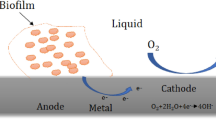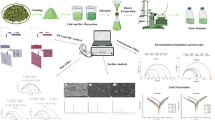Abstract
Herein, Elaeocarpus seed (ES) extract was studied in 3 M HCl solution as a efficacy corrosion inhibitor for the mild steel through mass loss, electrochemical Tafel diagrams, impedance spectroscopy, atomic absorption spectroscopy, scanning electron microscopy, and EDX techniques. During weight loss technique, it is observed that increasing the concentration enhances the protective role of the plant product. The Tafel diagrams showed a mixed role of the ES extract. In impedance spectroscopy, the area of depressed semicircle has a direct relationship with the plant extract concentration, which clearly demonstrating the inhibition property of ES extract. 93.370, 97.111, 89.015, and 90.528% are the maximum inhibition efficiencies obtained from the weight loss, atomic absorption spectroscopy, Tafel plot, and impedance spectroscopy techniques, respectively. Mathematical and quantum chemical studies further support the experimental results.
Graphic abstract















Similar content being viewed by others
Change history
08 April 2021
A Correction to this paper has been published: https://doi.org/10.1007/s11668-021-01147-1
References
D. Nestoridia, Pletcher, The study of aluminium anodes for high power density Al/air batteries with brine electrolytes. J. Power. Sour. 178, 445–455 (2008)
E.M. Sherif, S.M. Park, Effects of 1, 4-naphthoquinone on aluminum corrosion in 0.50 M sodium chloride solutions. Electrochim. Acta. 51, 1313–1321 (2006)
E.J. Lee, S.J. Pyun, The effect of oxide chemistry on the passivity of aluminum surfaces. Corros. Sci. 37, 157–168 (1995)
R.T. Loto, Q. Tobilola, Corrosion inhibition properties of the synergistic effect of 4-hydroxy-3-methoxybenzaldehyde and hexadecyltrimethylammoniumbromide on mild steel in dilute acid solutions. J. King Saud Univ. Eng. Sci. (2016). https://doi.org/10.1016/j.jksues.2016.10.001
N. Raghavendra, J. Ishwara Bhat, Red arecanut seed extract as a sustainable corrosion inhibitor for aluminum submerged in acidic corrodent. Period. Polytech. Chem. 62, 351–6358 (2018)
N. Chaubey, Y. Dk, V.K. Singh, M.A. Quraishi, A comparative study of leaves extracts for corrosion inhibition effect on aluminium alloy in alkaline medium. Ain Shams Eng. J. 8, 673–682 (2017)
F.M. BinYehmed, A.M. Abdullah, Z. Zainal, Z.M. Ruzniza, Green coffee bean extract as a green corrosion inhibitor for aluminium in artificial acid rain medium. Int. J. Appl. Environ. Sci. 13, 171–183 (2018)
N. Palaniappan, L. RajuChowhan, S. Jothi, I.G. Bosco, I.S. Cole, Corrosion inhibition on mild steel by phosphonium salts in 1M HNO3 aqueous medium. Surf Interface. 6, 237–246 (2017)
M.H. Othman Ahmed, A.A. Al-Amiery, Y.K. Al-Majedy, A.A.H. Kadhum, A.B. Mohamad, T.S. Gaaz, Synthesis and characterization of a novel organic corrosion inhibitor for mild steel in 1 M hydrochloric acid. Results Phys. 8, 728–733 (2018)
N. Raghavendra, J. IshwaraBhat, Green approach to inhibition of corrosion of aluminum in 0.5 M HCl medium by tender arecanut seed extract. Res. Chem. Intermed. 42, 6351–6372 (2016)
N. Raghavendra, J. IshwaraBhat, Natural products for material protection: an interesting and efficacious anticorrosive property of dry arecanut seed extract at electrode (aluminum)–electrolyte (hydrochloric acid) interface. J. Bio. Tribo. Corros. 2, 21 (2016)
A. Saxena, D. Prasad, R. Haldhar, Use of Asparagus racemosus extract as green corrosion inhibitor for mild steel in 0.5 M H2SO4. J. Mater. Sci. 53, 8523–8535 (2018)
U.F. Ekanem, S.A. Umore, I.I. Udousoro, A.P. Udoh, Inhibition of mild steel corrosion in HCl using pineapple leaves (Ananas comosus L.) extract. J. Mater. Sci. 45, 5558 (2010)
M. HazwanHussin, M. JainKassim, The corrosion inhibition and adsorption behavior of Uncaria gambir extract on mild steel in 1 M HCl. Mater. Chem. Phys. 125, 461 (2011)
A. Singh, I. Ahamad, V.K. Singh, M.A. Quraishi, Inhibition effect of environmentally benign Karanj (Pongamia pinnata) seed extract on corrosion of mild steel in hydrochloric acid solution. J. Solid State Electrochem. 15, 1087 (2011)
G. Ji, S.K. Shukla, P. Dwivedi, S. Sundaram, R. Prakash, Inhibitive effect of argemone mexicana plant extract on acid corrosion of mild steel. Ind. Eng. Chem. Res. 50, 11954 (2011)
P.K. Dixit, S. Dixit, M. Bhardwaj, B. Chauhan, K. Nagarajan, J. Sahoo, A review on traditional and ethnomedicinal uses of Elaeocarpus ganitrus(Rudraksha). Int. J. Pharm. Sci. Rev. Res. 52, 1 (2018)
G. Kumar, L. Karthik, K. Venkata, B. Rao, A review on medicinal properties of elaeocarpus ganitrus Roxbex. G.Don. (Elaeocarpaceae). Res. J. Pharm. Tech. 7, 1 (2014)
J.Y. Bao, M. Cai, G. Sun, G. Wang, H. Corke, Anthocyanins, flavonoids and free radical scavenging activity of myrialrubia extracts and their color properties and stability. J. Agric. Food Chem. 53, 2327 (2005)
N. Raghavendra, Theoretical approaches on the corrosion inhibition property of some important medicinal compounds against industrial imperative metals via computational methods. Res. J. Chem. Sci. 9, 1 (2019)
N. Raghavendra, J. IshwraBhat, Application of green products for industrially important materials protection: an amusing anticorrosive behavior of tender arecanut husk (green color) extract at metal-test solution interface. Measurement. 135, 625–639 (2019)
N. Raghavendra, Green compounds to attenuate aluminum corrosion in HCl activation: a necessity review. Chemistry Africa 3, 21 (2020). https://doi.org/10.1007/s42250-019-00114-6
S. Boudhiba, K. Hanini, I. Selatnia, A. Saouane, M. Hioun, S. Benahmed, Experimental, theoretical and mathematical studies of Echium italicum L. extract as a corrosion inhibitor for carbon steel in acidic medium. (Res. Express, Mater, 2019) https://doi.org/10.1088/2053-1591/ab194f.2019
P.M. Krishnegowda, V.T. Venkatesha, P. Kumar, M. Krishnegowda, S.B. Shivayogiraju, Acalypha torta leaf extract as green corrosion inhibitor for mild steel in hydrochloric acid solution. Ind. Eng. Chem. Res. 52, 722–728 (2013)
L.R. Chauhan, G. Gunasekaran, Corrosion inhibition of mild steel by plant extract in dilute HCl medium. Corros. Sci. 49, 1143–1161 (2007)
P.E. Alvarez, M.V. Fiori, A. Bimbi, A. Neske, S.A. Brandán, C.A. Gervasi, Rollinia occidentalis extract as green corrosion inhibitor for carbon steel in HCl solution. J. Ind. Eng. Chem. 58, 92–99 (2018)
E. Ituen, O. Akaranta, A. James, S. Sun, Green and sustainable local biomaterials for oilfield chemicals: Griffonia simplicifolia extract as steel corrosion inhibitor in hydrochloric acid. Sustain. Mater. Technol. 11, 12 (2017)
N. Raghavendra, J.I. Bhat, Chemical components of mature areca nut husk extract as a potential corrosion inhibitor for mild steel and copper in both acid and alkali media. Chem. Eng. Commun. 205, 145–160 (2018)
N. Raghavendra, J.I. Bhat, Chemical and electrochemical studies on the areca fat as a novel and sustainable corrosion inhibitor for industrially important materials in hostile fluid environments. J. Bio. Tribo. Corros. 3, 12 (2018)
N. Raghavendra, Areca plant extracts as a green corrosion inhibitor of carbon steel metal in 3 M hydrochloric acid: gasometric, colorimetry and atomic absorption spectroscopy views. Mol. Eng. Mater. (2019). https://doi.org/10.1142/S2251237318500041
J.C. Rocha, J.A.C.P. Gomes, E. Delia, Corrosion inhibition of carbon steel in hydrochloric acid solution by fruit peel aqueous extracts. Corros. Sci. 52, 2341 (2010)
Author information
Authors and Affiliations
Corresponding author
Ethics declarations
Conflict of interest
Author Narasimha Raghavendra declares no conflict of interest.
Additional information
Publisher's Note
Springer Nature remains neutral with regard to jurisdictional claims in published maps and institutional affiliations.
The original online version of this article was revised: Reference 22 has been corrected.
Rights and permissions
About this article
Cite this article
Raghavendra, N., Kumaraswamy, B.E. Elaeocarpus Seed Extraction and Their Impact as a Corrosion Inhibitor for Mild Steel Submerged in HCl Wash Solution: Insight from Experimental, Mathematical, and Theoretical Views. J Fail. Anal. and Preven. 21, 958–975 (2021). https://doi.org/10.1007/s11668-021-01141-7
Received:
Revised:
Accepted:
Published:
Issue Date:
DOI: https://doi.org/10.1007/s11668-021-01141-7




